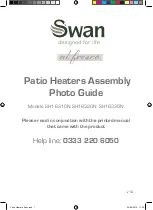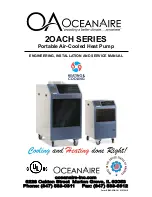
8
9
I
Quando si accende il riscaldatore, una bassa corrente alternata ad alta
tensione passa attraverso i numerosi avvolgimenti della bobina primaria.
Tutto ciò induce un’alta corrente a bassa tensione nel pezzo in lavorazione,
che funge da bobina secondaria, e questa alta corrente comporta il
riscaldamento del pezzo in lavorazione.
La corrente scorre solo nel pezzo in lavorazione, provocando un inizio
di riscaldamento esclusivamente in tale pezzo. Quest’ultimo viene
smagnetizzato automaticamente al termine di ciascun ciclo termico.
3.
Installazione
• Rimuovere il materiale d’imballaggio e posizionare il riscaldatore ad
induzione su una superficie piana, stabile e non ferrosa. In genere la
scatola contiene il riscaldatore, un giogo o un set di gioghi magnetici, la
sonda per la temperatura, un paio di guanti termoresistenti e una piccola
confezione di lubrificante.
• Verificare che la corrente e la tensione di rete soddisfino le specifiche
riportate sulla targhetta identificativa presente sul retro della macchina.
• Poiché esistono diversi tipi di spine, non tutti i riscaldatori ad induzione
Timken vengono forniti con la spina. Nel caso in cui il riscaldatore sia
sprovvisto di spina, è necessario farne applicare una adeguata da un
elettricista qualificato.
• I fili elettrici dovranno essere collegati come indicato di seguito. Esistono
3 opzioni a seconda del tipo di cavo con cui viene fornito il riscaldatore:
230V/110V Riscaldatori monofase
Marrone
Fase
Nero
Fase
Nero“1”
Neutro
Blu
Neutro
Blanc
Neutro
Nero“2”
Fase
Verde/giallo
Terra
Verde
Terra
Verde/giallo
Terra
400, 450, 500V Riscaldatori bifase
Marrone
Fase
Marrone
Fase
Nero“1”
Fase
Blu
Fase
Nero
Fase
Nero“2”
Fase
Verde/giallo
Terra
Verde/giallo
Terra
Verde/giallo
Terra
noticeheaterI.indd 9
17/10/06 14:19:09
Summary of Contents for VHIN 10
Page 204: ...noticeheaterRU indd 2 17 10 06 14 30 28...
Page 206: ...4 1 5 150o C 302o F noticeheaterRU indd 4 17 10 06 14 30 28...
Page 207: ...5 RU in out 1 noticeheaterRU indd 5 17 10 06 14 30 29...
Page 211: ...9 RU 3 3 230V 110V 1 2 400 450 500V 1 2 noticeheaterRU indd 9 17 10 06 14 30 30...
Page 212: ...10 4 noticeheaterRU indd 10 17 10 06 14 30 31...
Page 213: ...11 RU 5 5 2 1 in out noticeheaterRU indd 11 17 10 06 14 30 32...
Page 214: ...12 5 1 2 150 C noticeheaterRU indd 12 17 10 06 14 30 34...
Page 216: ...14 6 240 464 F VHIN10 noticeheaterRU indd 14 17 10 06 14 30 38...
Page 219: ...17 RU 8 noticeheaterRU indd 17 17 10 06 14 30 38...
Page 224: ...noticeheaterPRC indd 2 17 10 06 14 32 31...
Page 226: ...4 1 5m 16ft 150o C 302o F noticeheaterPRC indd 4 17 10 06 14 32 32...
Page 227: ...5 PRC in out 1 3 3ft noticeheaterPRC indd 5 17 10 06 14 32 32...
Page 231: ...9 PRC 3 3 230V 110V 1 2 400 450 500V 1 2 noticeheaterPRC indd 9 17 10 06 14 32 34...
Page 232: ...10 4 noticeheaterPRC indd 10 17 10 06 14 32 34...
Page 233: ...11 PRC 5 5 2 1 in out noticeheaterPRC indd 11 17 10 06 14 32 35...
Page 234: ...12 5 1 2 150 C 302 F noticeheaterPRC indd 12 17 10 06 14 32 37...
Page 236: ...14 6 2 4 0 o C 4 6 4 o F VHIN10 noticeheaterPRC indd 14 17 10 06 14 32 41...
Page 239: ...17 PRC 8 noticeheaterPRC indd 17 17 10 06 14 32 41...
Page 244: ...Notes noticeheaterGB indd 22 17 10 06 15 56 16...
Page 245: ...Notes noticeheaterGB indd 22 17 10 06 15 56 16...
Page 246: ...Notes noticeheaterGB indd 22 17 10 06 15 56 16...
Page 248: ...A1 noticeheaterGB indd 24 17 10 06 15 56 20...
Page 249: ...A2 noticeheaterGB indd 25 17 10 06 15 56 38...
















































